| I
receive a lot of letters from the States, nearly always extremely kind
and often far too complimentary. Even so, they make me very happy.
I had been going through some old letters, as I have to
clear them out periodically, when I found the following letter, and
this extract is perfect fro what I want to say. It was written by a
very famous breeder just after I last judged in the States (1975). He
wrote "It was my great pleasure to have met and talked with you, I
agreed with all you said and hopefully we will meet again. Veronica,
your evaluation of Basenjis in America is a true and honest one, and we
are all guilty of not holding to the standard. But please believe me
when I say that some of us are trying."
You must
remember that I have not done any breeding for a number of years, so I
have axe to grind, and never have I hope. I have always tried to stick
to the standard so carefully taught to me by the famous pioneers of the
breed: Mrs. Burn, the late Lady Helen Nutting, Lady Kitty Ritson,
Captain Richards and Mr. K. B. Smith, all of whom knew Basenjis in the
Congo and South Sudan. Once you have seen a number of the right type
anything else is displeasing to the eye.
What
worried me when I judged in America were so many long muzzles and quite
a lot of round light eyes. Many of the muzzles were as long as the
skull with some even longer. The original description was that the
muzzle should be approximately one third the length of the skull. The
skull is measured from stop to the highest point on top of the head.
I have even heard it said that some in America want
"balanced" heads. It was explained to me that a balanced head is when
the skull is equal in length to the muzzle. My description of this
would be an "unbalanced" head. It is totally wrong and completely
spoils the unique Basenjis expression. A good test of this change in
the Basenji head is to take the "blue Basenji book" which I wrote in
1954 (with a number of later reprints) and note that practically every
dog illustrated has a short muzzle and typically correct Basenji
expression. Then compare those heads with various editions of THE
BASENJI. I think you will find a big change in heads and expressions -
and they are certainly not for the better: with muzzles too long, some
with a fill-up like a bull-terrier, eyes round and light (even in black
and white photos you can judge a light eye by its being pale, with a
black pupil showing up distinctly), other eyes are set too high, or too
close together giving a mean appearance. Some of the heads would do
justice to Collies.
This warning doesn't just
apply to the States. We are getting some bull-terrier type heads in
Britain; Australia is getting light eyes and a few long muzzles. We are
all losing wrinkle. Perhaps this well meant warning will make people
take a long clear look at their dogs and see faults in them which they
had not noticed. These faults can be bred out. | |
UNTYPICAL HEADS
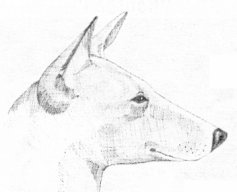
Illustration A:
Bull-terrier type head with long muzzle, filled between the eyes and
eyes set too high in the head giving a mean appearance.
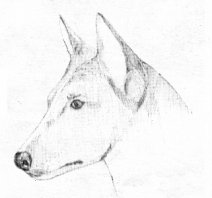
Illustration B: Filled out collie type head with long muzzle and a
light eye.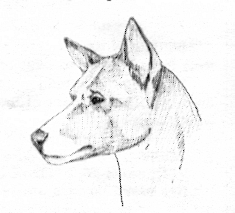
Illustration C: Low-set ears, light
nose, long and heavy muzzle with heavy underjaw which is not uncommon
in some lines without being undershot. Heavy jowl and neck go together.
Nice eye.
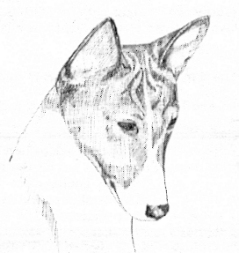
Illustration D: There is little
difference between the plane of the forehead and muzzle, it is not
filled out, but rather as though the head was pushed in. The muzzle is
long.
|
| These
photographs represent a sampling of typey Basenji heads including some
of the original stock imported from Africa, some dogs from years gone
by and some current dogs in several countries. Note overall shape of
the head, relationships of planes, length of muzzle, and shape, color
and location of the eyes. 

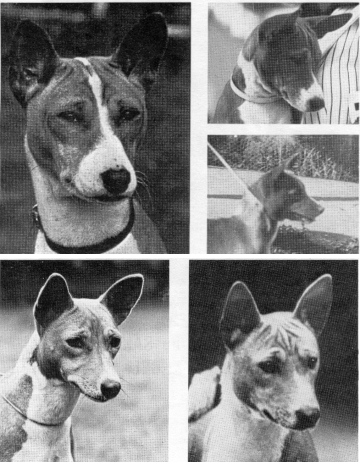 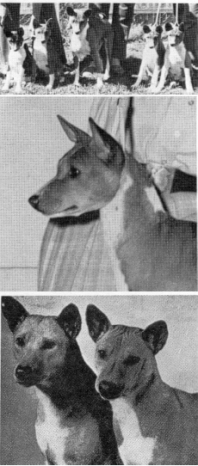
|